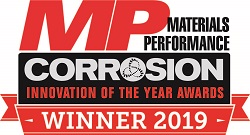A new additive system comprised of a liquid healing agent encapsulated by a polymeric shell is increasingly being used to boost the anticorrosive properties of protective coatings.
According to Autonomic Materials, Inc. (AMI) (Champaign, Illinois, USA), which developed the technology and branded it as the AMPARMOR 2000 series, the innovation comes in the form of a patented additive technology. The additive is comprised of a microencapsulated healing agent containing an epoxy resin, polar diluent, corrosion inhibitors, and adhesion promoters.
The updated testing system was one of 10 winners selected by a panel of corrosion industry experts for the 2019 MP Corrosion Innovation of the Year Awards, honored in March 2019 in Nashville, Tennessee, USA. Further technical details and case histories are available at the awards web site.
Limitations of Traditional Systems
 The company explains that, in many circumstances, protective coatings are initially sufficient to protect metal substrates that may be subject to corrosive environments. However, once damaged in a way that exposes the underlying substrate, corrosion can begin and typically propagates in the form of undercutting at the coating-substrate interface.
The company explains that, in many circumstances, protective coatings are initially sufficient to protect metal substrates that may be subject to corrosive environments. However, once damaged in a way that exposes the underlying substrate, corrosion can begin and typically propagates in the form of undercutting at the coating-substrate interface.
This undercutting process compromises the coating’s adhesion to the substrate, leading to
delamination and impairment of the coating’s ability to protect the substrate.
“The best coating systems designed for the protection of metal assets typically perform remarkably well until they are compromised in some way,” says Gerald O. Wilson, AMI’s vice president of technology development. “The lifetime of a coating system is, therefore, defined by its ability to adequately provide protection to the underlying substrate in service. Once compromised, the coating will rapidly degrade, leading to the exposure and oxidation of the underlying substrate.”
In turn, most asset owners then need to repair or replace the original coating, according to the company.
New System Benefits
In their new system, the additive’s microcapsules are formulated into water-borne and solvent-borne liquid epoxy coatings, zinc-rich primers, powder coatings, and fusion-bonded epoxy coatings. Once fully cured, damage to these coatings ruptures the microcapsules. This releases the healing agent into the site of damage, where it polymerizes, seals the edge of the damage, delays undercutting, and facilitates maintenance of the coating’s adhesion.
The improved maintenance of adhesion keeps the coating in service longer, which minimizes the extent of recoating and maintenance required and lost productivity due to downtime over an asset’s lifetime.
“Mechanical damage such as scratches and micro-cracks that stem from impact from typical use and weathering conditions are common in most protective coating applications,” Wilson explains. “These damage mechanisms to a coating containing self-healing additives will result in the rupture of the microcapsules, followed by release of the healing agents into the site of damage where polymerization occurs. This seals off the damage and prevents adhesion loss due to moisture penetration or undercutting.”
Technology Details
According to the company, the additive is manufactured via a microencapsulation process from an oil-in-water emulsion. The oil phase is comprised of the healing agent blend, while the polymeric shell wall containing the healing agent is built via an in situ polymerization process.
A slurry results from the encapsulation process, which can be used without further processing in water-borne coating applications or spray-dried for solvent-borne or powder coatings. For all coating formulations, the capsules occupy volume in the coating formulation and contribute to the pigment volume concentration of the coating.
The capsules prepared for these applications range in sizes from 5 microns (0.2 mil) to 25 microns (1.0 mil), allowing for sizes similar to commonly used pigments and fillers and compatibility with coating dry film thicknesses of 25 microns (1.0 mil) and greater.
Other than routine and expected adjustments to the formulation and following guidelines regarding order of entry, the incorporation of these additives into existing coating formulations does not require any meaningful changes to batch making or coating application processes, according to the company.
Commercially Available
The first commercially available self-healing coating containing the additives was launched in 2017. In addition to its originally targeted use for industrial maintenance applications, the self-healing coating is currently at various stages of field trials for specification in the oil and gas industry as part of multi-coat protective systems in demanding environments.
“AMI’s self-healing additives can lower the cost of maintaining assets in both moderate and extreme locations; from ubiquitous urban water towers to remote offshore oil rigs,” Wilson says.
Testing data in powder and liquid coating systems is available at the awards web site, while preparations for field trials in locations, including Trinidad, the Gulf of Mexico, and the North Sea are ongoing, according to the company.
Source: Autonomic Materials, Inc., www.autonomicmaterials.com. Contact Gerald O. Wilson—e-mail: gw@autonomicmaterials.com.